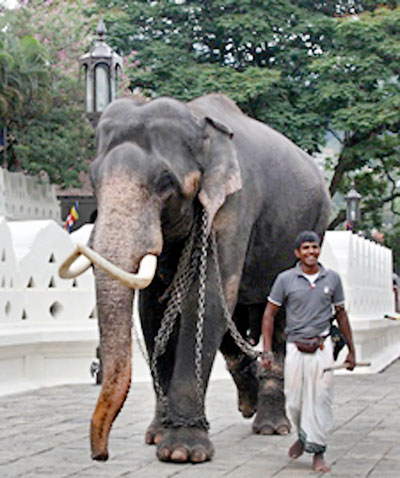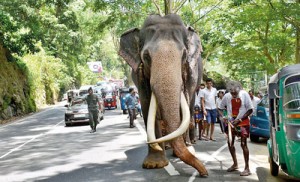News
Entrancing tale of the Esala’s mighty tusker

The final night of the Esala Perahera
Few know the story behind the majestic, seven-foot-high tusker, Indiriraja, which carried the Golden Karanduwa on some days in the just concluded Esala Perahera, the only pageant in the world where humans and animals in such large numbers mingle without the least harm to any of them.
It all came about in 1987, when the famous Maligawa elephant, Raja, was ailing. The then Diyawadana Nilame, Neranjan Wijeratne, consulted the respected veterinarian of the University of Peradeniya, Professor Vijitha Kuruwita, who was the vet for the Sri Dalada Maligawa.
The Diyawadana Nilame decided, notwithstanding the political climate in the country, to approach the Indian Prime Minister, Rajiv Gandhi for assistance. He contacted the Venerable Mapalagama Vipulasara Thera, who was the President of the Mahabodhi Society in India, to arrange a meeting with the Indian leader.
Accompanying the Diyawadana Nilame was a formidable delegation comprising the Mahanayake of Asgiri, the Venerable Palipanne Chandananda, Anunayake of Malwatte, the Ven. Panditha Pahamunegunanda Thera, a member of the Asgiri Karaka Sangha Sabha theVenerable Palipanne Sirinivasa Thera and Professor Kuruwita. The appointment was arranged and the Lankan delegation met Prime Minister Gandhi in New Delhi.
After a long discussion, during which Mr. Gandhi presented the Diyawadana Nilame with a book on elephants, the Ven. Palipanne Chandananda expressed the view that the challenges facing India and Sri Lanka could be bridged if the Indian leader could offer a tusker to the Sri Dalada Maligawa in order to show the people that India is their friend.
The Prime Minister immediately told the delegation he would arrange for them to select a tusker from the Mundumalai Elephant Training Centre, which lies between the states of Karnataka and Ootacamund.

Indiriraja
The Diyawadane Nilame and Prof. Kuruwita stayed two weeks at the centre to select a tusker that would suit the requirements of the Sri Dalada Maligawa. They saw Indiriraja, which fitted the requirements of a tusker to carry the Golden Karanduwa. Seven feet in height, the elephant had an almost flat back that was suitable to strap the Ransivige, which encases the Golden Karanduwa. An Indian veterinarian, Dr. Krishnamoorthy, aided Prof. Kuruwita in the selection.
The controversial Indian High Commissioner, J.N. Dixit, deputised in handing over the elephant to Neranjan Wijeyratne, who says Indiriraja was strapped with the Ransivige three months after his arrival, trained first for the Poson procession and then for the Kartika Mangalya and finally for the Kandy Esala Perahera.
Since 1990, Indiriraja has been doing the honours at the Sri Dalada Maligawa, carrying the casket for close upon 26 years. It is not easy being strapped with foot-wide leather straps and other paraphernalia, but the majestic tusker is always calm and dignified.
According to the former Diyawadane Nilame and trainer Seneviratne, Indiriaja hates the goad and has been trained only with a stick.
Sunil Rambukpotha, who was on the staff of the Sri Dalada Maligawa, recalls that when Veterinarian Krishnamoorthy while attending a symposium in Sri Lanka had come to the Maha Maluwa to see Indiriaja the tusker had recognised Dr. Krishnamoorthy by his voice.

| Nadungamuwe Raja on his way home
Nadungamuwe Raja’s journey to Sri Lanka is one that began across the miles in the city of Mysore in the Indian state of Karnataka. It is in this city of kings that the tusker was born around 1954. Nadungamuwe Raja was one of two elephant calves gifted by a Maharaja of Mysore to a veteran native physician monk who was residing at the Nilammahara Temple in Piliyandala. The physician monk’s ability to cure various ailments had given him fame far and wide and as the story is told, a relative of the Maharajah of Mysore was among those the monk cured. It was in appreciation for curing his relative’s prolonged illness, the two tuskers were gifted. In the late 70s, the tusker was acquired by Dharmavijaya Veda Ralahamy of the Nadungamuwa area, an eminent ayurvedic physician of the time and it is by the name of this village the tusker is known today. His present owner is Harsha Dharmavijaya, the son of the Veda Ralahamy of Nedungamuwa. |


 The majestic tusker Nadungamuwe Raja, the bearer of the casket containing the sacred tooth relic on some days at the Esala Maha has started its long trek back home. The journey of nearly 100 kilometres to his home at Nedungamuwa in the Gampaha District takes him and his mahout Wilson Kodituwakku nearly five days but it’s a journey on foot done at a leisurely pace. Nadungamuwe Raja prefers walking in the night and spending the rest of the day lazing around for long hours in the water.
The majestic tusker Nadungamuwe Raja, the bearer of the casket containing the sacred tooth relic on some days at the Esala Maha has started its long trek back home. The journey of nearly 100 kilometres to his home at Nedungamuwa in the Gampaha District takes him and his mahout Wilson Kodituwakku nearly five days but it’s a journey on foot done at a leisurely pace. Nadungamuwe Raja prefers walking in the night and spending the rest of the day lazing around for long hours in the water.